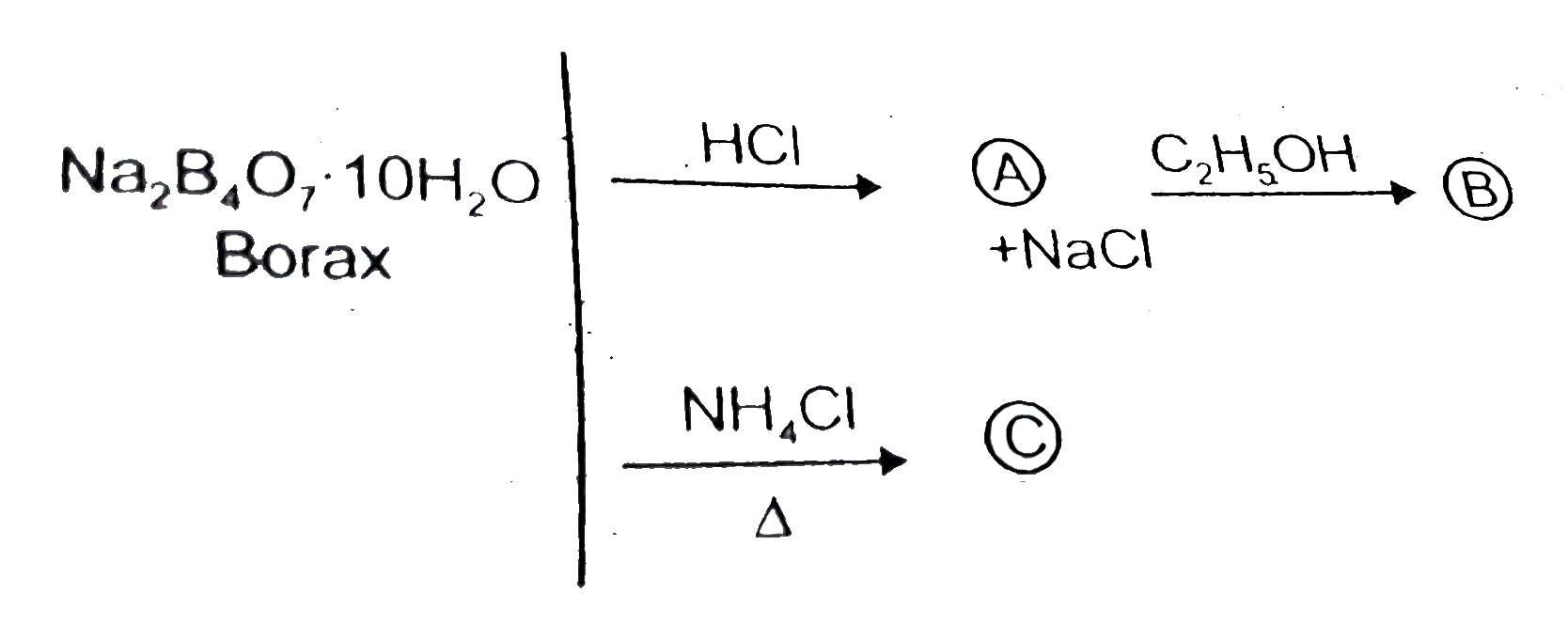Complete Solutions to Assignment Section-D) of chapter THE P-BLOCK ELEMENTS of Class 12 book with complete answers and questions
| Class 12 | CHEMISTRY |
| Chapter | THE P-BLOCK ELEMENTS |
| AAKASH INSTITUTE | Assignment Section-D) |
| Number Of Questions | 15 |
| Academic Year | 2023-24 |

Q. In the above reaction the product (C) resembles with
View Solution
Q. Hybridization of B in compound (B) is
View Solution
Q. Borax structure contains
View SolutionQ. Which of the following statement is correct regarding `C_(60)` fullerene?
View SolutionAllotropes of carbon: There are three forms of carbon. i.e., diamond, graphite and fullerene which exxist in crystalline form. Graphite and diamond occur in nature. The structure of diamond is tetrahedral with `sp^(3)` hybridisation and diamond exist in 3-D netowrk solid. in graphite, carbon is `sp^(2)` hybridised. each carbon linked to other carbon linked to other carbon atom forms hexagonal ring. it has a layered structure. diamond and graphite are purest form of carbon. Fullerene constitute a new family of carbon allotropes.
Consisting of large spheroidal molecule of compound with general formula `C_(2n)`. common fullerene `C_(6),C_(70)`, contain 5 and 6 membered rings.
Q. Which of the following statement is incorrect for graphite?
View SolutionAllotropes of carbon: There are three forms of carbon. i.e., diamond, graphite and fullerene which exist in crystalline form. Graphite and diamond occur in nature. The structure of diamond is tetrahedral with `sp^(3)` hybridization and diamond exist in 3-D network solid. in graphite, carbon is `sp^(2)` hybridized. Each carbon linked to other carbon atom forms hexagonal ring. it has a layered structure. Diamond and graphite are purest form of carbon. Fullerene constitute a new family of carbon allotropes.
Consisting of large spheroidal molecule of compound with general formula `C_(2n)`. common fullerene `C_(6),C_(70)`, contain 5 and 6 membered rings.
Q. Which of the following statement is incorrect for graphite?
View Solution
If (C) is silicone, then answer the following questions.
Q. (A) and (B) are
View Solution
If (C) is silicone, then answer the following questions.
Q. Mode by which polymerisation is undergoing is
View Solution
If (C) is silicone, then answer the following questions.
Q. Structure of 'C' is
View SolutionNitrogen forms largest number of oxides in which oxidation state of nitrogen varies from +1 to +5 `N_(2)O,NO,N_(2)O_(3),N_(2)O_(4) and N_(2)O_(5)` respectively. The largest number of oxides are formed due to capability of forming stable multiple bonds by nitrogen with oxygen.
Q. Which of the following is/are correct statement(s)?
View SolutionNitrogen forms largest number of oxides in which oxidation state of nitrogen varies from +1 to +5 `N_(2)O,NO,N_(2)O_(3),N_(2)O_(4) and N_(2)O_(5)` respectively. The largest number of oxides are formed due to capability of forming stable multiple bonds by nitrogen with oxygen.
Q. Which of the following oxides is known as anhydride of nitric acid?
View SolutionNitrogen forms largest number of oxides in which oxidation state of nitrogen varies from +1 to +5 `N_(2)O,NO,N_(2)O_(3),N_(2)O_(4) and N_(2)O_(5)` respectively. The largest number of oxides are formed due to capability of forming stable multiple bonds by nitrogen with oxygen.
Q. Which of the following statements is/are correct regarding oxides of nitrogen?
View SolutionTin and lead form divalent Sn (II) and lead (II) and tetravalent i.e., Tin (IV) and lead. (IV) compounds. Tetravalent and dioxides of lead and Tin are amphoteric in nature. Lead tetra fluorite is ionic solid where as `PbCl_(4)` is covalent. `Pbl_(4)` does not exist. Lead (II) halides are white whereas `Pbl_(2)` is yellow in colour.
Q. Reaction of SnO with NaOH gives
View SolutionTin and lead form divalent Sn (II) and ead (II) and tetravalent i.e., Tin (IV) and lead. (IV) compounds. Tetravalent and dioxides of lead and Tin are amphoteric in nature. Lead tetra fluorite is ionic solid where as `PbCl_(4)` is covalent. `Pbl_(4)` does not exist. lead (II) halides are white whereas `Pbl_(2)` is yellow in colour.
Q. `Pbl_(4)` does not exist due to
View SolutionTin and lead form divalent Sn (II) and lead (II) and tetravalent i.e., Tin (IV) and lead. (IV) compounds. Tetravalent and dioxides of lead and Tin are amphoteric in nature. Lead tetra fluorite is ionic solid where as `PbCl_(4)` is covalent. `Pbl_(4)` does not exist. lead (II) halides are white whereas `Pbl_(2)` is yellow in colour.
Q. `SnCl_(2)` is solid whereas `SnCl_(4)` is liquid, this is because?
View Solution
Assignment Section-D) questions and complete solutions for chapter THE P-BLOCK ELEMENTS of AAKASH INSTITUTE ENGLISH of Class 12